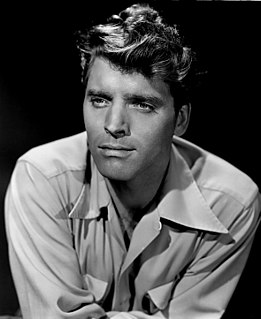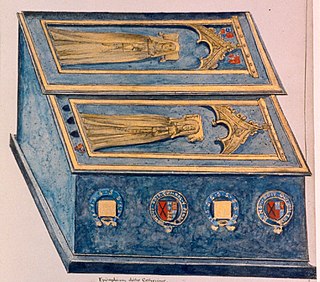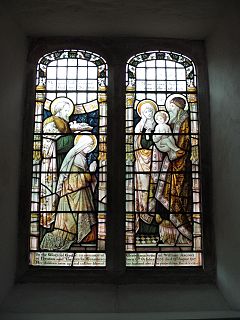See also
| This disambiguation page lists articles about people with the same name. If an internal link led you here, you may wish to change the link to point directly to the intended article. |
Thomas Lancaster (died 1583) was an English Protestant clergyman.
Thomas Lancaster may also refer to:
| This disambiguation page lists articles about people with the same name. If an internal link led you here, you may wish to change the link to point directly to the intended article. |

Burton Stephen Lancaster was an American actor and producer. Initially known for playing "tough guys" with a tender streak, he went on to achieve success with more complex and challenging roles over a 45-year career in film and, later, television. He was a four-time nominee for the Academy Award for Best Actor, and also winning two BAFTA Awards and one Golden Globe Award for Best Lead Actor.

Henry IV, also known as Henry Bolingbroke, was King of England from 1399 to 1413. He asserted the claim of his grandfather King Edward III, a maternal grandson of Philip IV of France, to the Kingdom of France.

John of Gaunt, Duke of Lancaster was an English prince, military leader, and statesman. He was the third of the five sons of King Edward III of England who survived to adulthood. Due to his royal origin, advantageous marriages, and some generous land grants, Gaunt was one of the richest men of his era, and an influential figure during the reigns of both his father, Edward, and his nephew, Richard II. As Duke of Lancaster, he is the founder of the royal House of Lancaster, whose members would ascend to the throne after his death. His birthplace, Ghent, corrupted into English as Gaunt, was the origin for his name. When he became unpopular later in life, scurrilous rumours and lampoons circulated that he was actually the son of a Ghent butcher, perhaps because Edward III was not present at the birth. This story always drove him to fury.

Katherine Swynford, Duchess of Lancaster, also spelled Katharine or Catherine, was the third wife of John of Gaunt, Duke of Lancaster, a son of King Edward III. She had been the Duke's lover for many years before their marriage. The couple's children, born before the marriage, were later legitimised during the reign of the Duke's nephew, Richard II. When the Duke's son from his first marriage overthrew Richard, becoming Henry IV, he introduced a provision that neither they nor their descendants could ever claim the throne of England, however, the legitimacy for all rights was a parliamentary statute that Henry IV lacked the authority to amend.

Lancaster (,) the county town of Lancashire, England, is on the River Lune and has a population of 52,234. The wider City of Lancaster local government district has a population of 138,375. The House of Lancaster was a branch of the English royal family, whilst the Duchy of Lancaster holds large estates on behalf of Elizabeth II, who is also the Duke of Lancaster. It is an ancient settlement, dominated by Lancaster Castle, Lancaster Priory Church and the Ashton Memorial. It is home to Lancaster University and a campus of the University of Cumbria.

The House of Lancaster was the name of two cadet branches of the royal House of Plantagenet. The first house was created when King Henry III of England created the Earldom of Lancaster—from which the house was named—for his second son Edmund Crouchback in 1267. Edmund had already been created Earl of Leicester in 1265 and was granted the lands and privileges of Simon de Montfort, 6th Earl of Leicester, after de Montfort's death and attainder at the end of the Second Barons' War. When Edmund's son Thomas, 2nd Earl of Lancaster, inherited his father-in-law's estates and title of Earl of Lincoln he became at a stroke the most powerful nobleman in England, with lands throughout the kingdom and the ability to raise vast private armies to wield power at national and local levels. This brought him—and Henry, his younger brother—into conflict with their cousin Edward II of England, leading to Thomas's execution. Henry inherited Thomas's titles and he and his son, who was also called Henry, gave loyal service to Edward's son—Edward III of England.

Lancaster Castle is a medieval castle in Lancaster in the English county of Lancashire. Its early history is unclear, but may have been founded in the 11th century on the site of a Roman fort overlooking a crossing of the River Lune. In 1164, the Honour of Lancaster, including the castle, came under royal control. In 1322 and 1389 the Scots invaded England, progressing as far as Lancaster and damaging the castle. It was not to see military action again until the English Civil War. The castle was first used as a prison in 1196 although this aspect became more important during the English Civil War. The castle buildings are owned by the British sovereign as Duke of Lancaster, which leases part of the structure to Lancashire County Council who operate a Crown Court in part of the building.

Earl of Derby is a title in the Peerage of England. The title was first adopted by Robert de Ferrers, 1st Earl of Derby, under a creation of 1139. It continued with the Ferrers family until the 6th Earl forfeited his property toward the end of the reign of Henry III and died in 1279. Most of the Ferrers property and the Derby title were then held by the family of Henry III. The title merged in the Crown upon Henry IV's accession to the throne in 1399.

Mary de Bohun was the first wife of King Henry IV of England and the mother of King Henry V. Mary was never queen, as she died before her husband came to the throne.

Thomas, Earl of Lancaster and Leicester was an English nobleman. A member of the House of Plantagenet, he was one of the leaders of the baronial opposition to his first cousin, Edward II of England.

Earl of Leicester is a title that has been created seven times. The first title was granted during the 12th century in the Peerage of England. The current title is in the Peerage of the United Kingdom and was created in 1837.

Henry, 3rd Earl of Leicester and Lancaster was a grandson of King Henry III (1216–1272) of England and was one of the principals behind the deposition of King Edward II (1307–1327), his first cousin.
Maud de Chaworth was an English noblewoman and wealthy heiress. She was the only child of Patrick de Chaworth. Sometime before 2 March 1297, she married Henry, 3rd Earl of Lancaster, by whom she had seven children.

The House of Plantagenet was a royal house which originated from the lands of Anjou in France. The name Plantagenet is used by modern historians to identify four distinct royal houses: the Angevins, who were also counts of Anjou; the main body of the Plantagenets following the loss of Anjou; and the Plantagenets' two cadet branches, the houses of Lancaster and York. The family held the English throne from 1154, with the accession of Henry II, until 1485, when Richard III died in battle.

Shrigley and Hunt was an English firm which produced stained glass windows and art tiles.
Events from the 1310s in England.

The High Sheriff of Lancashire is an ancient officer, now largely ceremonial, granted to Lancashire, a county in North West England. High Shrievalties are the oldest secular titles under the Crown, in England and Wales. The High Sheriff of Lancashire is the representative of the monarch in the county, and is the "Keeper of The Queen's Peace" in the county, executing judgements of the High Court through an Under Sheriff.
Thomas Lancaster was an English Protestant clergyman, Church of Ireland Archbishop of Armagh from 1568.

Ripley School Chapel is part of what is now the Ripley St Thomas Church of England Academy, located in Ashton Road, Lancaster, Lancashire, England. It is considered to be of architectural importance and is recorded in the National Heritage List for England as a designated Grade II* listed building.

Jacob Hay Brown was a Justice of the Supreme Court of Pennsylvania from 1899 to 1915 and Chief Justice from 1915 to 1921.